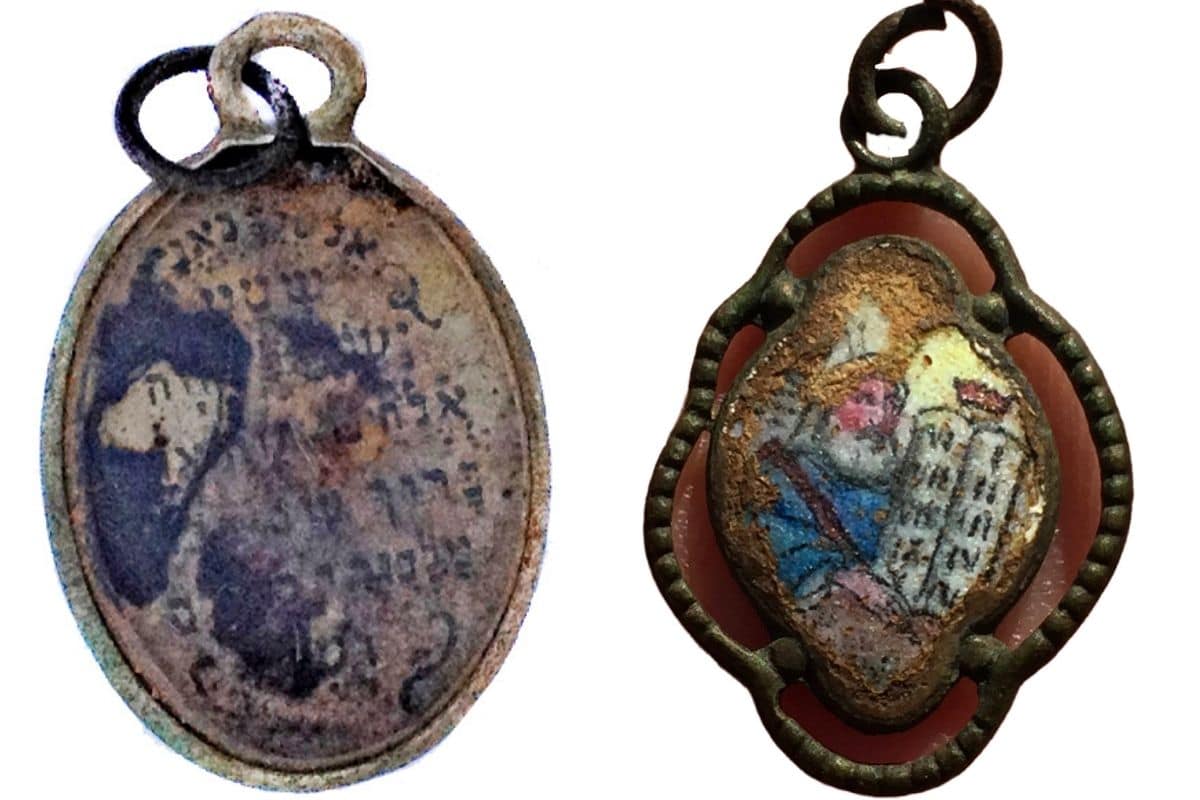
Jewish victims were forced to leave the pendants, along with their remaining jewelry and clothing, shortly before entering the gas chambers.
During excavations in Sobibor, a total of three Jewish pendants were found. Two of them were found in rooms where victims were forced to undress before entering the gas chambers. The third pendant was discovered near a mass grave in the infamous death camp in Poland.
Shema Yisrael
The pendants are all different, but also have a number of things in common. For example, on one side of each of the pendants is an image of Moses and the stone tablets with the Ten Commandments. On the other side is the handwritten Hebrew prayer ‘Shema Yisrael’ (Hear Israel). This prayer plays an important role in Judaism. For example, it is part of the morning and evening prayers and part of the prayer is also stored in the mezuzah: a small text tube that Jews put on the post from outside and some inside doors. Except at fixed times, the prayer is also said when someone is in mortal distress.
Eastern Europe
Research has shown that the three pendants come from Eastern Europe: Ukraine, Poland and what was then Czechoslovakia to be precise. That’s not a very surprising finding, says archaeologist Ivar Schute, who led the excavations in Sobibor together with Polish and Israeli archaeologists, but the pendants in question – which were discovered in 2016, but were only presented to the public at the end of last month – are not. (consciously) saw. “Most of the victims were Jewish Eastern Europeans.”
Unfortunately, we do not learn much more about the owners of these pendants, says archaeologist Yoram Haimi, affiliated with the IAA (Israel Antiquities Authority† “Little is known about the heartbreaking stories behind the pendants.” The pendants — which come from different parts of Eastern Europe, but have obvious similarities — do hint at the existence of a tradition or trend among Eastern European Jewish communities, in which members wore pendants bearing the well-known prayer on one side. and on the other side a picture of Moses and the law. But this tentative finding also raises new questions, Haimi acknowledges. “Were they distributed in synagogues by local Jewish communities or perhaps produced on demand?” Follow-up research should show that.

Here you see two of the recovered pendants. Prayer on the left. On the right the image of Moses and the law. Image: IAA.
Abandoned
While the pendants thus raise some new questions, they leave little to the imagination as to the fate of those who wore the pendants. They died in the gas chambers of Sobibor. It is easy to explain that more than seventy years later such silent witnesses are still waiting to be discovered in the extermination camp, says Schute. “Sobibor was demolished by the Germans. What the Germans didn’t want was left behind and later discovered in potholes, wells, pile tracks, and so on. An insane amount of discoveries have already been made.”
Valuable
And all those finds are all of great value. Because we know relatively little about Sobibor. “There are six extermination camps, all in Poland,” says Schute. Two of these – Majdanek and Auschwitz – also served as labor camps. “That’s why quite a lot is known about it: there are about a thousand testimonials about it. In addition, relatively much remains of these two camps. For the other four – Sobibor, Belzec, Treblinka and Chelmno – the number of survivors is very small. For example, Belzec has three survivors, one of whom has testified. Sobibor has about 50 survivors. Moreover, the Germans have razed these four camps to the ground: nothing is left of them.” It makes the archaeological finds a valuable source of information. And sometimes it is even the only source. “Of the fifty survivors of Sobibor, none have seen the gas chambers,” says Schute. “The foundations of it have been excavated by us.” Many of the victims’ belongings were also recovered. “We have recovered many tens of thousands of items.” Including the three pendants.
It is important work, Schute emphasizes. “Through archaeological research, structures can be seen that no one has seen. We can also discover objects that tell something about the people there.” The finds also make tangible what happened here decades ago; it is estimated that some 170,000 Jews were murdered in Sobibor. Nearly 35,000 of them came from the Netherlands. “Sobibor is the second largest Dutch mass grave after Auschwitz.”
Source material:
†Shema Yisrael pendants discovered in archaeological excavations in the Sobibor extermination camp in Poland” – Israeli Ministry of Foreign Affairs
Interview with Ivar Schute
Image at the top of this article: IAA